NEWS-1998: This page has been moved to http://czyborra.com/charsets/iso8859.html, substantially extended
and updated and is now accompanied by additional pages on ASCII, code
pages and Cyrillic
charsets.
ISO 8859 is a full series of 10 (and soon even more) standardized multilingual single-byte coded (8bit) graphic
character sets for writing in alphabetic languages:
- Latin1 (West European)
- Latin2 (East European)
- Latin3 (South European)
- Latin4 (North European)
- Cyrillic
- Arabic
- Greek
- Hebrew
- Latin5 (Turkish)
- Latin6 (Nordic)
The ISO 8859 charsets are not even remotely as complete as the truly
great Unicode but they have
been around and usable for quite a while (first registered Internet charsets for use with MIME) and have
already offered a major improvement over the plain 7bit US-ASCII.
Unicode (ISO 10646) will make this whole
chaos of mutually incompatible charsets superfluous because it unifies
a superset of all established charsets and is out to cover all the
world's languages. But I still haven't seen any software to display
all of Unicode on my Unix screen. We're working on it.
The ISO 8859 charsets were designed in the mid-1980s by the
European Computer Manufacturer's Association (ECMA) and endorsed by the
International Standards Organisation (ISO). The series is currently being revised by the ISO/IEC JTC1/SC2/WG3
working group. The 1998 editions all come with Unicode numbers.
This page exists because the ISO won't provide free
copies of their published standards (the charset subcommittee JTC1/SC2 has recently called
for a free online publication in the future, though, see their Redmond
resolution M08.02: Publication of SC 2 Standards on the web) and
the ECMA offers them on paper only.
By clicking at my [TXT]-buttons you can download textual reference
tables with Unicode mappings for each of the charsets. You may want
to double-check them against more authorative sources like Keld
Simonsen's pioneering RFC 1345, or his updated
and corrected charmaps for i18n@dkuug.dk, mirrored at many Linux's POSIX.2 /usr/share/i18n/charmap/ directory, the mapping tables on
ftp.unicode.org, or Kosta Kostis's transhtm-generated tables.
There are ISO 639 language codes for some 150 of the world's several
thousand known languages.
The 1998 editions of the ISO-8859 Latin alphabets come with a table of languages
covered.
A survey
of each language's characters was started by Harald Alvestrand.
A more complete but less computerized survey is Akira Nakanishi's
colorful book of the "Writing Systems of the World", ISBN 0-8048-1654-9.
It would be interesting to merge these two into an illustrative UTF-8 text file with Yudit.
The following bitmap GIFs show only the upper G1 portions of the
respective charsets. Characters 0 to 127 are always identical with US-ASCII and the positions 128 to 159 hold
some less used control characters: the so-called C1 set from ISO
6429.
Each image is followed by a link to the textual reference table and
the matching public-domain bitmap font source code in BDF bitmap distribution format so that you can integrate support
for all charsets in your metamail setup like I did in 1994 in cs.tu-berlin.de:/usr/elm/ before our beloved superuser
confiscated it because he felt competed or something.
Check out the commands mkfontdir and xset to install extra fonts on your X terminal.
If anybody has converters from BDF to other bitmap formats like those
for Windows or MacOS, please send them to me!
Most glyphs were extracted from etl16-unicode.bdf and
reassembled using a bunch of perl scripts.
``I'm really terrified to see how difficult it can
be for a non-latin1 person to be able to print in his/her own mother
tongue!'' -- Akim Demaille, maintainer of a2ps, early 1998
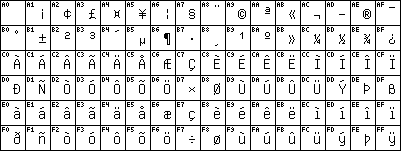
charset=ISO-8859-1
[TXT]
[BDF]
Latin1 covers
most West European languages, such as French (fr), Spanish
(es), Catalan (ca), Basque (eu), Portuguese (pt), Italian (it),
Albanian (sq), Rhaeto-Romanic (rm), Dutch (nl), German (de), Danish
(da), Swedish (sv), Norwegian (no), Finnish (fi), Faroese (fo),
Icelandic (is), Irish (ga), Scottish (gd), and English (en),
incidentally also Afrikaans (af) and Swahili (sw), thus in effect also
the entire American continent, Australia and much of Africa. The most
notable exceptions are Zulu (zu) and other Bantu languages using Latin Extended-B letters, and of course Arabic in North Africa,
and Guarani (gn) missing GEIUY with
~ tilde.
The lack of the ligatures Dutch IJ, French OE and ,,German`` quotation
marks is considered tolerable. The lack of the new C=-resembling Euro
currency symbol U+20AC has opened the discussion of a new Latin0.
Latin1 has also been adopted as the first page of ISO 10646 (Unicode). Latin1 is HTML's base
charset but HTML has now been globalized through RFC 2070. You can
browse the charset
smorgasbord or the impressive IUC10
poster to test your browser or let Andy Flavell tell you more
about the practical problems.
- DEC-MCS
-
ISO-8859-1 was derived from the DEC Multinational Character Set
used on the standard DEC VT-220 terminals:

charset=DEC-MCS
[TXT]
[BDF]
- CP1252 (WinLatin1)
-
You often see Microsoft Windows users (check out my code page survey) announcing their texts as
being in ISO-8859-1 even when in fact they
contain funny characters from the CP1252 superset (and they may become
more since Microsoft has also added the Euro to their code pages), so
here you have a Unix font for them:
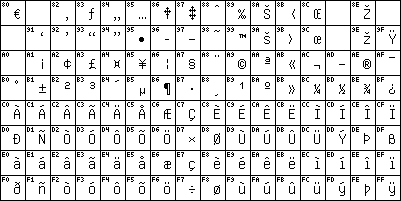
charset=Windows-1252
[TXT]
[BDF]
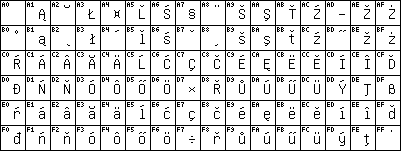
charset=ISO-8859-2
[TXT]
[BDF]
Latin2 covers the languages of Central and Eastern Europe:
Czech (cs), Hungarian (hu), Polish (pl),
Romanian (ro), Croatian (hr), Slovak (sk), Slovenian (sl), Sorbian.
For Romanian the S and T had better use commas instead of cedilla as
in Turkish: the U+015F LATIN SMALL LETTER S WITH CEDILLA at =BA ought
to be read as U+0219 LATIN SMALL LETTER S WITH COMMA BELOW etc.
The German umlauts äöüß are found at exactly the same positions in
Latin1, Latin2, Latin3, Latin4, Latin5, Latin6. Thus you can write
German+Polish with Latin2 or German+Turkish with Latin5 but there is
no 8bit charset to properly mix German+Russian, for instance.
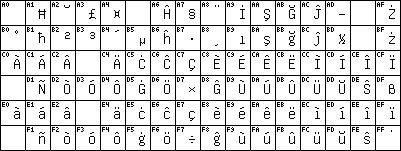
charset=ISO-8859-3
[TXT]
[BDF]
Latin3 is popular with authors of Esperanto (eo) and
Maltese (mt), and it covered Turkish before the introduction of Latin5 in 1988.
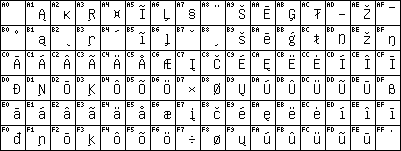
charset=ISO-8859-4
[TXT]
[BDF]
Latin4 introduced letters for Estonian (et), the Baltic languages Latvian (lv, Lettish) and Lithuanian (lt),
Greenlandic (kl) and Lappish. Note that Latvian requires the cedilla
on the =BB U+0123 LATIN SMALL LETTER G WITH CEDILLA to jump on top.
Latin4 was followed by Latin6.

charset=ISO-8859-5
[TXT]
[BDF]
With these Cyrillic letters you can type Bulgarian (bg),
Byelorussian (be), Macedonian (mk), Russian (ru), Serbian (sr) and
pre-1990 (no ghe with upturn)
Ukrainian (uk). The ordering is based on the (incompatibly) revised
GOST 19768 of 1987 with the Russian letters except for ë sorted by
Russian alphabet (ABVGDE).
Note that several other Cyrillic
charsets are used on the net. Have a look at my neighboring Cyrillic charsets page.

charset=ISO-8859-6
[TXT]
[BDF]
This is the Arabic alphabet, unfortunately the basic
alphabet for the Arabic (ar) language only and not containing the four
extra letters for Persian (fa) nor the eight extra letters for
Pakistani Urdu (ur). This fixed font is not well-suited for text
display. Each Arabic letter occurs in up to four (2²) presentation
forms: initial, medial, final or separate. To make Arabic text
legible you'll need a display engine that analyses the context and
combines the appropriate glyphs on top of a handler for the reverse
writing direction shared with Hebrew. The
rendering algorithm is described in the Unicode
book and I have implemented it in my arabjoin perl script.
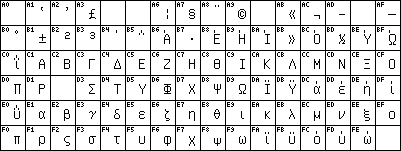
charset=ISO-8859-7
[TXT]
[BDF]
This is (modern monotonic) Greek (el) to me. ISO-8859-7 was
formerly known as ELOT-928 or
ECMA-118:1986.

charset=ISO-8859-8
[TXT]
[BDF]
And this is the Hebrew script used by Hebrew (iw) and Yiddish (ji). Like
Arabic it is written leftwards,
so get your dusty old bidirectional typewriters out of the closet! We
are promised to see a Bidirectional Algorithm Reference Implementation
published as Unicode Technical Report #9 in the near future.

charset=ISO-8859-9
[TXT]
[BDF]
Latin5 replaces the rarely needed Icelandic letters ðýþ in Latin1 with the Turkish ones.
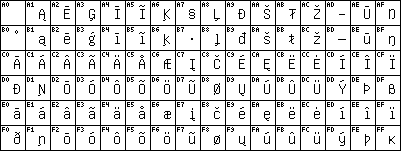
charset=ISO-8859-10
[TXT]
[BDF]
Introduced in 1992, Latin6 rearranged the Latin4 characters, dropped some symbols and the Latvian ŗ,
added the last missing Inuit (Greenlandic Eskimo) and non-Skolt Sami
(Lappish) letters and reintroduced the Icelandic ðýþ to cover the
entire Nordic area. Skolt Sami still needs a few more accents.
Note that RFC 1345 and GNU
recode contain errors and use a preliminary and different latin6.
From information to be found on Michael Everson's website and the official WG 3 website I gathered
that in the near future we shall get to see new parts to ISO-8859
which may look like these:

charset=ISO-8859-11
[TXT]
[BDF]
The Thai TIS620 is likely to be published as ISO-8859-11 Latin/Thai
(th). It contains some combining vowel and tone marks that have to be
written above or below the consonants.
There is currently no draft numbered ISO-8859-12. This number
might be reserved for ISCII Indian.
It is unlikely that there will ever be a Vietnamese part.
Vietnamese (vi) seems to be the language using the most accentuated
letters of all languages using the Latin script. Some letters carry a
combination of two different accents. They are so many that they
simply don't fit into the model of ISO-8859. You can use VISCII instead.

charset=ISO-8859-13
[TXT]
[BDF]
Latin7 is going to cover the Baltic Rim and re-establish the
Latvian (lv) support lost in Latin6 and may introduce the local
quotation marks. It resembles WinBaltic.

charset=ISO-8859-14
[TXT]
[BDF]
Latin8 adds the last Gaelic and Welsh (cy) letters to Latin1 to
cover all Celtic languages.

charset=ISO-8859-15
[TXT]
[BDF]
The new Latin9 nicknamed Latin0 aims to update Latin1 by replacing the less needed symbols
¦¨´¸¼½¾ with forgotten French and Finnish letters and placing the
U+20AC Euro sign in the cell =A4 of the former international currency
sign ¤.
On 1998-06-28 I suggested to heed the lesson learned and base
Latin9 on ISO-8859-9 instead of Latin1
because there is a much greater use for Turkish than for Icelandic but
apparently that proposal did not sway the WG3 standardizers.
From: misha.wolf@reuters.com
Date: 22 Jun 1998
To: unicode@unicode.org
Subject: Re: Outlook & the Euro
> ISO 8859-15 will probably be implemented by a number of
vendors, but it will take some time until a large percentage of the
users start using those versions. Until then, it might be wise *not*
to make 8859-15 the default when sending mail.
We have just the place for ISO 8859-15 here in London. It is
called the Science Museum and is full of charming historical relics,
like Babagge's difference engine, used by Ada Lovelace (I think that
was her family name).
What a relief that we now have Unicode and won't have to implement
this amusing piece of history.
But with good Unicode support, adding yet
another charset is a piece of cake. And
the Euro will be needed on systems limited to 8bit. ISO-8859-15 fonts
and keysyms have already been included in X11 R6.4 fix #02.
Blurb
I started this page as http://www.cs.tu-berlin.de/~czyborra/charsets/
on February 27, 1995, in reaction to a request for ISO-8859 code
charts on comp.std.internat.
Until then, there had only been lousy scans of the ISO charts floating
around on the net besides textual tables. I could easily throw this
together since I had already gathered all the necessary X11 fonts from
MULE's, Barry Bouwsma's and Kosta
Kostis' collections. Since then has the charsets page had more
than ![[a bitmapped number]](http://wwwwbs.cs.tu-berlin.de/cgi/count/~czyborra/charsets/) accesses, got copied, included in books,
CD-ROMs, and even translated into French.
Because of network turbulences at cs.tu-berlin.de that shook the
referer database I can only offer you an old list of who referred to the charsets page.
accesses, got copied, included in books,
CD-ROMs, and even translated into French.
Because of network turbulences at cs.tu-berlin.de that shook the
referer database I can only offer you an old list of who referred to the charsets page.
Thanks go to Sven-Ove Westberg, Alexandre Khalil, Andreas Prilop,
Jacob Andersen, Stavros
Macrakis, Doug Newell, Chrystopher Nehaniv, Alan Watson, Aaron Irvine,
Jonathan Rosenne, Christine Kluka, Clint Adams, Arnold Krivoruk, Van
Le, Jörg
Knappen, Thomas Henlich, Chris Maden, Paul Keinänen, Christian
Weisgerber, Kent Karlsson, Markus Kuhn, Pino Zollo, Imants
Metra, Jukka Korpela, and
Paul Hill who provided valuable hints for corrections to this page.
You are welcome to mail your criticism to roman@czyborra.com.
Roman Czyborra
$Date: 1998/12/01 12:39:22 $















